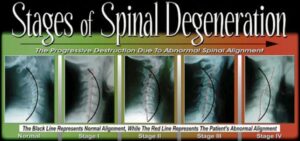Subluxation Degeneration: Effects Over Time and the Importance of Early Intervention
Introduction
Understanding the health of your spine is crucial to maintaining overall well-being. One of the most significant threats to spinal health is subluxation degeneration. In this comprehensive guide, we will explore what subluxation degeneration is, its effects over time, and why waiting to address it can lead to worsening conditions. Early chiropractic intervention plays a vital role in managing and preventing the progression of subluxation degeneration.
What is Subluxation Degeneration?
Subluxation degeneration refers to the gradual deterioration of spinal structures due to a misalignment or dysfunction of the vertebrae. This condition can lead to nerve interference, reduced mobility, and chronic pain. Subluxations can result from various factors, including poor posture, physical trauma, repetitive stress, and even emotional stress.
Stages of Subluxation Degeneration

Subluxation degeneration progresses through several stages, each with increasing severity and more significant impact on spinal health and overall well-being.
Stage 1: Dysfunction
In the initial stage, minor misalignments occur, leading to altered biomechanics and minor nerve interference. Symptoms may include occasional discomfort or stiffness. At this stage, subluxations can often be corrected relatively easily with chiropractic adjustments.
Stage 2: Early Degeneration
As subluxations persist, the body begins to adapt to the misalignment, resulting in early degeneration. This stage is characterized by decreased disc height, minor bone spurs, and increased discomfort. Regular chiropractic care can help manage symptoms and slow the progression.
Stage 3: Intermediate Degeneration
At this stage, the degenerative changes become more pronounced. Disc height continues to decrease, bone spurs become more substantial, and nerve interference intensifies. Symptoms often include chronic pain, reduced mobility, and potential radiating pain. Chiropractic care is essential to manage symptoms and maintain mobility.
Stage 4: Advanced Degeneration
In the final stage, the spine undergoes significant structural changes. Discs may become severely thinned or herniated, and bone spurs can cause severe nerve compression. Pain and mobility issues are typically severe, and surgical intervention may be considered. Chiropractic care at this stage focuses on pain management and maintaining quality of life.
Effects of Subluxation Degeneration Over Time
The effects of subluxation degeneration can vary depending on the severity and duration of the condition. Here are some of the common long-term effects:
- Chronic Pain: Persistent subluxations can lead to chronic pain in the back, neck, and extremities due to ongoing nerve interference and inflammation.
- Reduced Mobility: Degeneration can limit the range of motion and flexibility, making everyday activities challenging.
- Nerve Damage: Prolonged nerve interference can cause nerve damage, leading to numbness, tingling, and weakness in the affected areas.
- Postural Changes: As the body compensates for misalignments, it can lead to poor posture, further exacerbating spinal issues.
- Decreased Quality of Life: Chronic pain and reduced mobility can significantly impact the quality of life, affecting work, hobbies, and overall well-being.
The Importance of Early Intervention
Early intervention is critical in managing subluxation degeneration. Addressing subluxations promptly can prevent the progression to more severe stages and mitigate long-term effects. Here are some reasons why early chiropractic care is essential:
- Preventing Progression: Early chiropractic adjustments can correct misalignments before they lead to significant degeneration, preserving spinal health.
- Pain Relief: Early intervention can alleviate pain and discomfort, improving overall quality of life.
- Improved Mobility: Regular chiropractic care helps maintain and improve mobility, allowing individuals to stay active and engaged in daily activities.
- Reduced Risk of Surgery: Addressing subluxations early reduces the likelihood of requiring invasive surgical interventions.
- Overall Health Benefits: A healthy spine supports overall health, as proper nerve function is essential for various bodily functions.
Why Waiting Always Makes it Worse
Delaying treatment for subluxation degeneration can lead to worsening symptoms and more challenging treatment outcomes. Here’s why waiting is not an option:
1. Progressive Nature of Degeneration
Subluxation degeneration is a progressive condition. Without intervention, the degenerative changes continue to worsen over time, leading to more severe symptoms and greater impairment.
2. Increased Pain and Discomfort
As degeneration progresses, pain and discomfort become more pronounced. What might start as occasional stiffness can evolve into chronic, debilitating pain that affects every aspect of life.
3. Reduced Effectiveness of Treatment
Early-stage subluxations are often easier to correct with chiropractic adjustments. As the condition advances, treatment becomes more complex and less effective, requiring more intensive interventions.
4. Higher Risk of Complications
Advanced subluxation degeneration can lead to complications such as herniated discs, severe nerve compression, and even permanent nerve damage. These complications often require surgical intervention, which carries its own risks.
5. Greater Impact on Quality of Life
Chronic pain, reduced mobility, and other symptoms associated with advanced subluxation degeneration can significantly impact daily life, work, and overall well-being. Early intervention helps maintain a higher quality of life.
Benefits of Chiropractic Care
Chiropractic care offers numerous benefits for individuals suffering from subluxation degeneration. Here’s how chiropractic care can help:
- Spinal Adjustments: Chiropractic adjustments correct misalignments, restoring proper spinal function and reducing nerve interference.
- Pain Management: Chiropractic care provides effective pain relief, reducing the need for pain medications and invasive procedures.
- Improved Mobility: Regular chiropractic care helps maintain and improve mobility, enhancing the ability to perform daily activities.
- Prevention of Further Degeneration: By addressing subluxations early, chiropractic care helps prevent further degeneration and complications.
- Holistic Approach: Chiropractors often provide lifestyle and ergonomic advice, helping patients make positive changes to support spinal health.
Conclusion
Subluxation degeneration is a progressive condition that can have severe effects on spinal health and overall well-being. Early intervention through chiropractic care is crucial to managing and preventing the progression of this condition. Delaying treatment can lead to increased pain, reduced mobility, and more complex treatment requirements. By seeking chiropractic care early, individuals can enjoy better pain management, improved mobility, and a higher quality of life. Don’t wait—take proactive steps to protect your spine and overall health today.


